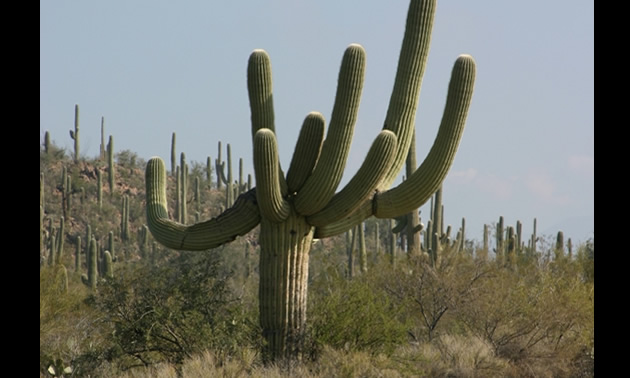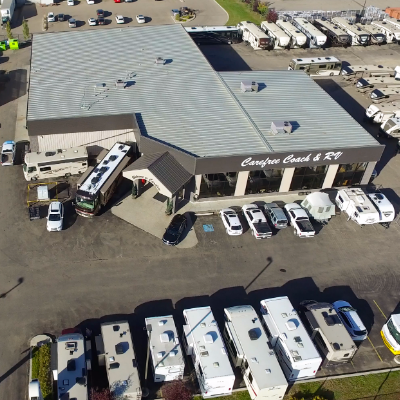Top things to see and do in Tucson
Explore a desert museum or a thriving artists’ colony

It’s tough to choose the top attractions in the Tucson area–there are so many. But the first stop has to be the visitor information centre. There you can purchase a visitor's passport that highlights many of the attractions in the area and gives you excellent discounts on admission prices.
The Tucson area is diverse and the inhabitants share and celebrate that diversity. The city is built in and surrounded by volcanic mountains and desert. Even the name Tucson comes from a Spanish adaptation of the O’odham tribe’s word for “at the base of the black hill.”
Natural attractions include the Arizona-Sonora Desert Museum, Sabina Canyon and the Saguaro National Park.
1.) Arizona-Sonora Desert Museum
Our choice for the top natural attraction is the desert museum. It sits on 98 acres with 3.2 kilometres (2 miles) of walking paths covering 21 acres. Most of the property is covered with natural growth and cacti. As you wander along the paths, many of the plants are labelled for identification. You pass enclosures that house large animal like cougars, bobcats and jaguars.
There are snake and reptile exhibits as well as a hummingbird area, where some of the birds are so tame they pose to have their pictures taken. Guided tours and demonstrations are scheduled throughout the day. The raptor free flights demonstration we saw featured a Peregrine falcon and other birds, which swooped just above our heads and then would perch on a nearby cactus for photographs.
2.) Saguaro National Park: Bookend parks of Tucson
Second only to the desert museum are the east and west portions of Saguaro National Park, which sit like bookends on either side of the city of Tucson. It made me think of a forest–if there is such a thing as a cactus forest.
Saguaro cactus grows very slowly and usually starts under the protection of a nurse tree or shrub--often a creosote, mesquite or palo verde--which provides shade and moisture for germination. Slowly the cactus grows, maybe an inch a year, by stealing nutrients from the nurse plant. The nurse then dies off, leaving the cactus to grow from 15 to 50 feet. The Desert USA website says the largest plants, with more than five arms, are estimated to be 200 years old. An average old saguaro is about 30 feet tall.
Saguaro West has shorter hiking trails and petroglyphs, while Saguaro East is a hikers delight.
3.) Cultural and historic attractions
Archaeologists claim that this area was visited by paleo-Indian people as long ago as 12,000 years. They have found evidence of irrigated farming and the red and black ceramics produced by the ancient Hohokam peoples.
Over the centuries, control of the area moved back and forth from Spain to Mexico to the United States, with the occasional Apache battle. Finally, in the mid 1800s the Gadsden Purchase formally brought this southern Arizona area under the control of the United States.
4.) Mission San Xavier
The first Catholic mission of San Xavier founded by Father Eusebio Kino in 1692 still stands and is the oldest intact European structure in Arizona. It’s been named a National Historic Landmark.
5.) Tubac and the artists’ colony
About an hour south of Tucson on the way to Nogales, Mexico, is an old settlement that once housed a Spanish garrison and is now a thriving artists’ community. Walking through the streets is like walking through a gigantic gallery of art and working artists. The streets are lined with artists and their wares.
At the Karin Newbury Gallery and Sculpture Garden, sculptures are interspersed with garden plots.
6.) DeGrazia Gallery in the Sun
It’s difficult to describe the DeGrazia Gallery in the Sun experience. The gallery is a complex of buildings scattered over 10 acres in the hills of north Tucson. The buildings and the setting exemplify the spirit and backdrop surrounding the entire city–natural desert with an array of plants and cacti. Impressionistic sculptures are sprinkled throughout--and that is even before you go into the gallery.
DeGrazia’s Gallery itself is room after room filled with Ted DeGrazia’s impressionistic sketches, paintings and sculptures of the southern Arizona he loved and lived from the 1940s to the 1970s. In addition to his physical environment, DeGrazia was enthralled with the Mexican Indian lifestyle and children. He was incredibly prolific and the entire complex is filled with his work.
7.) Tucson’s top shows and fiestas
The Tucson Gem and Mineral Show, one of the largest in the world, is held for two weeks in February.
The Fiesta de los Vaqueros, or rodeo week, is also held in February. It is billed as “the world's largest non-mechanized parade.”






